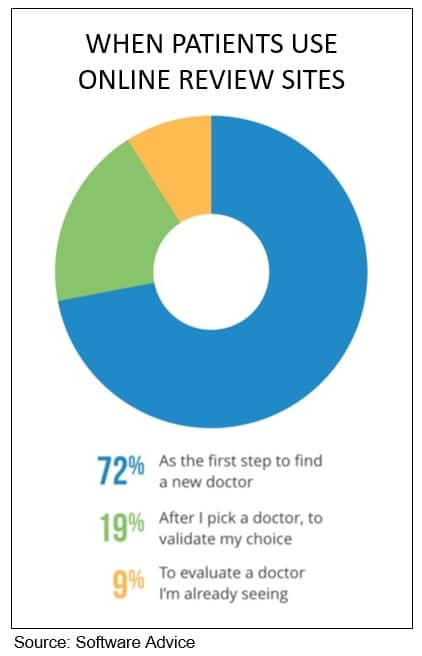A solid reputation and a steady flow of referrals have long been primary means for doctors to build and sustain a successful medical practice. That’s no different today, but how those referrals are earned has changed quite a bit. Modern-day doctors are building their reputations through positive patient reviews online. That includes reviews, ratings and recommendations, as well as social media likes, mentions, comments and shares.

A whopping 82% of patients use online review sites to evaluate physicians, according to Software Advice, an independent provider of detailed reviews on thousands of software applications. The survey goes on to report these findings:
- 72% of patients use online reviews as their first step in finding a new doctor or medical specialist.
- Nearly half of respondents said they would go out of their insurance network for a doctor with favorable reviews.
- Only 7% of patients leave “very negative” or “somewhat negative” feedback on review sites.
If those statistics aren’t enough to convince you, consider the fact that millennials will be the most sought-after patients of the near future. If you’re a physician and you don’t have a healthy online rating, you might as well not exist with millennials.
Now that you’re sold on the importance of building your online reputation, how do you, as a physician or surgeon, manage online reviews in the buzzing, shape-shifting universe of online publishers? We’re glad you asked.
5 steps to jump-start positive patient reviews for your medical practice
1. Take inventory of your online presence
Besides your own medical practice website, where else do you show up on the web? There are likely to be a number of online listings that pertain to your practice.

Physicians often don’t realize that Google and Facebook will create location listings and social media pages for them if they don’t do it themselves. You may have patient reviews on these sites, as well as leading medical review sites like Healthgrades and RateMDs.
Start by simply searching your name or practice name to see what comes up. You can also use the free tool at www.yext.com to discover other online directory listings for your practice.
2. Update and actively maintain your profiles and listings
Claim the listings for your practice and your individual doctors, so you have a say in the content. Once you have control of your listings, you can add or update physician photos, practice address(es) and contact information. Many listings will convey practice specialties, hours of operation, links to your website and social media sites, and more.
Keep in mind that claiming your listings doesn’t mean you can delete negative patient reviews. But it’s important for your practice information to be accurate, consistent and complete to enable search engines to find and understand your business.
3. Start cultivating positive patient reviews
First and foremost, encourage your doctors, nurses and front desk staff to provide top quality care and service that is deserving of positive patient reviews. Then ASK for reviews.
Equip your docs with “review us online” hand-out cards to give to patients after a positive interaction. Post signs at your check-in and check-out desks letting patients know where they can go to review your practice and your doctors.
You may also want to consider using a review software platform to automate the process of gathering and managing reviews. These systems can be pricey, but if you’re serious about attracting new patients, they can really pay off.
4. Monitor reviews and respond to them
Always respond on your own review sites (like Google and Facebook) and on third-party healthcare review sites where you are able to add a comment. Respond to positive reviews with a note of thanks.
Negative reviews require a bit more thought. Keep your cool, be humble, choose your language carefully (“we” is better than “I”), acknowledge the patient’s concern, and show an effort to correct the issue. Depending on the situation, you may decide to respond in a public forum (on the site where the review was written), or it may be more appropriate to take it offline with an email or phone call directly to the individual. Often, a dissatisfied patient simply wants to know they’ve been heard.

5. Don’t be afraid of negative reviews
Many of our medical practice clients are surprised to learn that only 7% of patients write “very” negative or “somewhat negative” reviews. This data is encouraging and suggests that there is a great deal more to gain from online reviews than there is to lose.
If you do get a negative review, use the feedback to learn about how others view your practice. Try to objectively consider the criticism, and determine if there are changes you need to make in your practice operations or bedside manner that will create more positive patient experiences.
It’s important to note that positive patient reviews are only one component of a doctor’s online reputation. While you can’t always control what patients have to say about you or your practice, you can control your own messages on the internet. Publish online content that represents your practice’s brand and reflects your attitude – professional, helpful, kind, compassionate, cutting-edge, whatever it may be. Carry that message across all of your online assets, from your website and blog to your social media sites, e-newsletters, digital advertising and the way everyone in your practice interacts with patients. Reinforce your messages with clarity, consistency and frequency.
Still not sure how to get started? Group3 can help. We’re a full-service marketing agency in Raleigh, NC, that focuses on medical practice marketing. We encourage our medical practice clients to embrace online reviews as a central component of their marketing strategy. By providing qualitative insight into specific patient concerns, review sites give you a platform to hear what patients have to say. They offer ideas for practices to improve the overall patient experience. And they are taking the place of traditional word-of-mouth referrals from one patient to another. Contact us to learn more.



